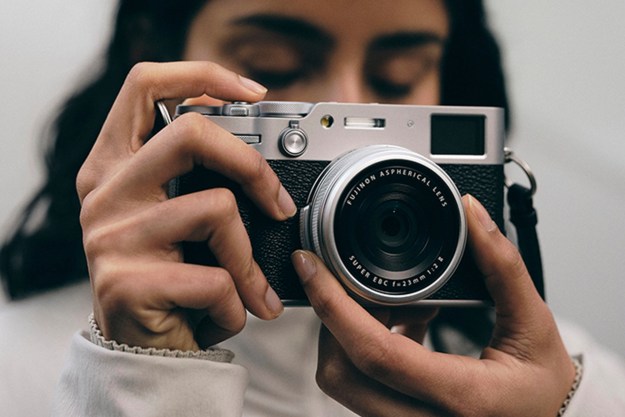- 10MP for less than $400; very good image quality; excellent on-screen menus; good response time
- Poor focusing with Quick Focus mode; bad movie mode; no printed owners manual
Summary
I’ve covered digital cameras for too long. It seems every conversation starts out–”remember when…” As in remember when a three-megapixel camera like the Minolta RD-3000 cost $3,000 back in the day (circa 1999)? Three MP cameras are landfill today or objects of curiosity on eBay, with 6-megapixels the current entry level. Now there’s a wave of 10MP point-and-shoot cameras coming, with the Casio EX-Z1000 the first of many. Unfortunately I can’t tell you about the others since I’ve been sworn to secrecy by major camera makers. Take my word for it though–10MP compact digicams will be the rage this holiday season. And this doesn’t count D-SLRs like the Sony DSLR-A100, the Nikon D200 and Sony’s all-in-one DSC-R1.
A price of 400 clams is pretty amazing for a 10MP camera especially when the others mentioned start at $900. Are you giving something up with the Casio? Of course since there are no free lunches in this world. Now how much are you giving up–and does it pay to invest $399 in the Exilim Zoom EX-Z1000? That’s what we’ll tell you over the next few pages.
Features and Design
Casio is known for ultra skinny digicams like the Exilim Card series such as the EX-S600. This 6MP digicam measures 3.54 x 2.52 x .63 (WHD, in inches), weighs 4.1 ounces without battery, has a 3x optical zoom and a 2.2-inch LCD. The EX-Z1000 is 3.62 x 2.3 x .88 and weighs 4.9 ounces. This is a long way of saying the 10.1MP Exilim is very compact and won’t break your back. In fact, I popped it into my pocket during my trek to the wilds of Alaska while trying out the Sony DSLR-A100 just to see how the two 10MP imaging devices compared (more on this later).
Unlike the Exilim Cards, this one only has a metallic silver case, rather than the kicky orange or blue of the EX-S600. The EX-Z1000 is rather unassuming with no ostentatious logos or design elements. It simply looks like a silver candy bar. And it looks and feels substantial. The camera has a 3x optical zoom (38-114mm 35mm equivalent) with a built-in lens cover. Also on the front is an AF Assist lamp, a flash and tiny microphone. There’s nothing on either side. The top of the camera is only slightly less minimal with a tiny power on/off button, keys for playback and capture, a display button to change LCD brightness and other options as well as the zoom toggle switch surrounding the shutter.
The rear of the camera is dominated by a 2.8-inch LCD monitor rated a fine 230K pixels. Strangely it has a 14:9 aspect ratio rather than the more familiar 16:9 widescreen format. In case you’re wondering, the EX-Z1000 can take 16:9 snapshots but the resolution drops from 3648 x 2736 pixels to 3648 x 2048 (both in the best mode).
Along with the screen (there is no viewfinder) there are just a few of the basic controls on the back that are found on every digicam. These include a four-way controller with center set key as well as a buttons for access to menus and Casio’s extensive roster of Best Shot (BS) options. Best Shot is the company’s phrase for Scene settings and you’ll find everything you can think of including an eBay mode for taking shots that’ll go with your auction listings.
The camera is supplied with everything you need other than an SD memory card so budget another $50 for a one gig edition. One of the reasons the camera is so small there are no inputs or outputs on the body itself. The supplied A/V out and USB cables are routed from a supplied dock that also charges the battery. The battery is rated a decent 360 shots per the CIPA standard. Unfortunately, there’s no printed Owner’s Manual, just a very basic guide (about 14 pages in English). The rest of the manual is on the CD ROM, a real pain for those who want to delve into the finer mysteries of their cameras. Not many people walk around with a laptop to peruse their owner’s manuals so get ready to print some pages out. The CD ROM also has Photo Loader V3.0, Photohands V1.0, drivers and Adobe Reader. Mac users get Photo Loader V1.1. It’s pretty basic stuff but enough to give you a taste of photo editing.
After charging the camera in the dock and loading a 2GB SD card, it was time to take some images.
Image Courtesy of Casio
Performance
The Casio Exilim Zoom EX-Z1000 is ready to go in less than two seconds once you hit the tiny power key. Make sure you don’t trim your nails too short since you’ll need an edge to press the button. The lens quickly extends from the body and the LCD screen pops to life. As usual we started out in Auto Snapshot mode and then worked our way through many of the other options available including many Best Shot settings.
The LCD screen worked well in a variety of situations including very bright sunshine. As noted, the LCD has that unusual 14:9 shape. What this offers you is rather cool. You can display all of the camera’s key settings in a narrow vertical band on the right and they don’t clutter the screen. Just hit the Display key and you can get the layout that works best for you. You can even have the histogram on view as you’re shooting. With all the key icons on the right, you can make adjustments as the need fits while viewing a standard image. You can adjust the flash, focusing, anti-shake on/off, ISO, white balance and exposure compensation. It’s very easy to read and follow; Casio engineers get high-marks for this system and their onscreen menus overall. Only HP Photosmarts and Kodak EasyShares are in the same ballpark.
Initially when I used the camera I had some difficulty getting accurate focus but checking in the Owner’s Manual on 65, I discovered the camera has a factory default setting for Quick Focus that helps you grab quick shots. The manual said if you want more accurate focus you should turn it off. Well, if you buy this camera, make sure you do just that. The results were like night and day during my test. I also switched from multi point to spot focus; that helped as well.
As mentioned earlier, I took 10MP shots of the same subject using the Casio and a prototype of the Sony DSLR-A100. This was really like having the 2006 Detroit Tigers play your local Little League team–a very unfair comparison given the capabilities of each but on paper it’s still 10MP vs. 10MP. The Casio uses a 1/1.8-inch sensor while the Sony is a full APS-C sized CCD used in D-SLRs. As we’ve reported many times before, when you cram too many pixels on a small sensor, the end result is digital noise. And the Casio has it when you up the ISO beyond 100 (400 is the max).
I made 8 ½ x 11 prints of totem poles and other subjects and surprisingly the Casio held its own. When you put them side-by-side you could see the Sony was more accurate while the Casio was a bit warmer (more yellow). Still if you used the Casio as your only camera–as most people would–you’d be very happy with the results.
As mentioned the Casio has noise issues while I didn’t see any with the Sony until 800. And as for response time–forget it; the Sony or any other D-SLR blows it away. Still the EX-Z1000 did a reasonable job saving 10-megapixel files to a high-speed card. Image detail was good without blown highlights and there was little purple fringing. Noise is the real downer here at higher ISOs.
Manual focus is available, as are seven white balance options but forget about anything like aperture- or shutter-priority. After all, it is a compact point-and-shoot digicam.
Like all compact digicams, the EX-Z1000 takes video clips, in this case 640 x 480 pixels at 25 frames per second rather than 30 fps. For me, these clips are good for grabbing a quick, few-second scene and will never take the place of a camcorder.
Image Courtesy of Casio
Conclusion
I was pleasantly surprised at the quality of this new 10MP point-and-shoot digicam. I really didn’t like the Casio EX-S500 but this digicam is definitely a shooter of a different color. The EX-Z1000 has a nice feel, superb onscreen menus, is simple to use and it takes good–not great–photos. I recommend it, especially if you can get it for around $350.
Pros
- 10MP for less than $400
- Takes very good images overall
- Excellent onscreen menus
- Good response time for a point-and-shoot
Cons
- Poor focusing with Quick Focus mode
- No aperture- or shutter priority modes
- Movie mode should be better
- No printed owner’s manual





